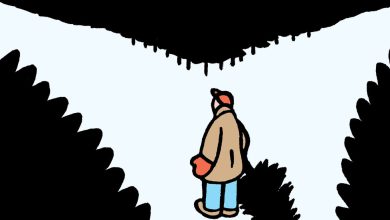The Woods Are Still Lovely, Dark and Deep, and We Have Promises to Keep

NASHVILLE — It was 78 degrees here on New Year’s Day, a record high for Nashville, and I broke into a sweat just packing for a weekend on the Cumberland Plateau. “Did you remember to bring your coat?” my husband asked when I got into the car.
It was not an unreasonable question, despite the heat. I hadn’t packed my coat when we left for the Cumberland Plateau last month. It was warm that day, too. In fact, it had been so warm for so long that the cherry laurels were already in bud. Who thinks to pack a coat when cherry laurels are in bud?
But the next day the temperature dropped to 45, and there I was, stranded in the woods with no coat nor even so much as a sweater. Apparently, this is how winter works now. Daffodils out of the ground, Lenten roses in full bloom two months out of time, and then wham.
I remembered my coat at New Year’s, which is fortunate because the following day brought a winter storm. Snow bellowed across the Southeast and up the Atlantic seaboard — an inch or two at home, more than four at the cabin where we were staying. That night, we lay in bed and listened to the wind howling up from Lost Cove, so loud it drowned out even the coyotes’ howls. Between gusts, we could hear the bare trees creaking as they swayed.
Two days later, the roads were clear enough for us to head home, barely in time to grab a smushed loaf of bread from the picked-over grocery shelves before another winter storm blew in. For an entire day, sunup to sundown, snow poured out of the sky. It snowed and snowed and snowed. On Twitter, Nashville Severe Weather warned that snow was accumulating “faster than the time they dumped all those pay scooters downtown.”
All told, we got 6.3 inches, another daily record. Extremes are our norm now.
Wherever you live, there are plenty of reasons to regard a winter storm with trepidation. Much of the danger hits entirely at random: power failures, downed trees, traffic snarls and hideous wrecks. As always, our most vulnerable — the unhoused and the working poor, those who live so close to the edge that missing a few days of work would mean financial ruin — are hit the hardest of all.
Though the science is not yet settled, a new study suggests that climate change is making these storms more common.
Nevertheless, snow has always been a feature of winter — even, from time to time, in the Deep South — so it comes as something of a relief when winter starts to look like winter again. After last month’s devastating tornadoes, normally a springtime danger, the pure glory of snow in this heat-benighted place is hard to convey.
The first thing you notice after the wind dies down, is the peace of snow, the hush of it, the way it slows everything to a human pace. All the machines have fallen silent, the backhoes and the chain saws and the leaf blowers. Stoplights wink red and yellow and green in the clotted, snow-blown air, and the roads are silent but for your own muffled footfall. Even the songbirds have ceased their singing. They need all their energy to keep warm.
Later, when it clears, children sled right down the middle of streets where adults habitually drive too fast on snow-bereft days. The kids squeal with the joy of speed and sanctioned transgression, but no one is so happy as the galloping neighborhood retrievers, their eyes alight, their shaken coats scattering diamonds in the frozen air.
Even so, snow conveys no beauty in cities or suburbs that comes even close to the magic it performs in a forest, coating every tree, every discrete branch and twig, turning the woods into a wonderland. The trunks of trees turn blacker in the wet, while the ground around them turns white then whiter still. It’s a black-and-white landscape now, a scene from a movie made in another age.
The whole world is clean, bathed in brightness. You can tell which way the storm came in by which side of the standing trees is also white, but you cannot see where the path dips or is tricked with fallen branches hidden in the whiteness. Watch your step, especially near the edges of ponds — the snow gathers so densely there that it’s impossible to see where the mud ends and the water begins.
One of the great gifts of snow in a forest is the chance to study animal tracks, to see where one deer peeled away from the group and then returned, to see where the group itself started out in one direction and then shifted to another. Animals change their minds! It is a magnificent, vibrant reminder that our wild sisters and brothers are every bit as individual as we are.
But as a metaphor for clarity and cleanness, snow inevitably falls short. Everything that lies beneath its sheltering blanket — the scarred land, the trash our species always leaves behind — is still there. The snow is only a temporary respite.
But for a moment, sometimes a few days, the woods are yet “lovely, dark and deep,” as Robert Frost so famously put it in “Stopping by Woods on a Snowy Evening.” We have promises to keep of our own — to the natural world, to our own very future — and they are as urgent as any in human history.
In the midst of so much turmoil, it is easy to forget what the snow tells us to do. Its hush, its clarity, above all its wonder — they remind us to stop and listen to the sweep “of easy wind and downy flake.” To stop and watch the “woods fill up with snow.”
To stop.
Margaret Renkl, a contributing Opinion writer, is the author of the books “Graceland, at Last: Notes on Hope and Heartache From the American South” and “Late Migrations: A Natural History of Love and Loss.”
The Times is committed to publishing a diversity of letters to the editor. We’d like to hear what you think about this or any of our articles. Here are some tips. And here’s our email: [email protected].
Follow The New York Times Opinion section on Facebook, Twitter (@NYTopinion) and Instagram.





